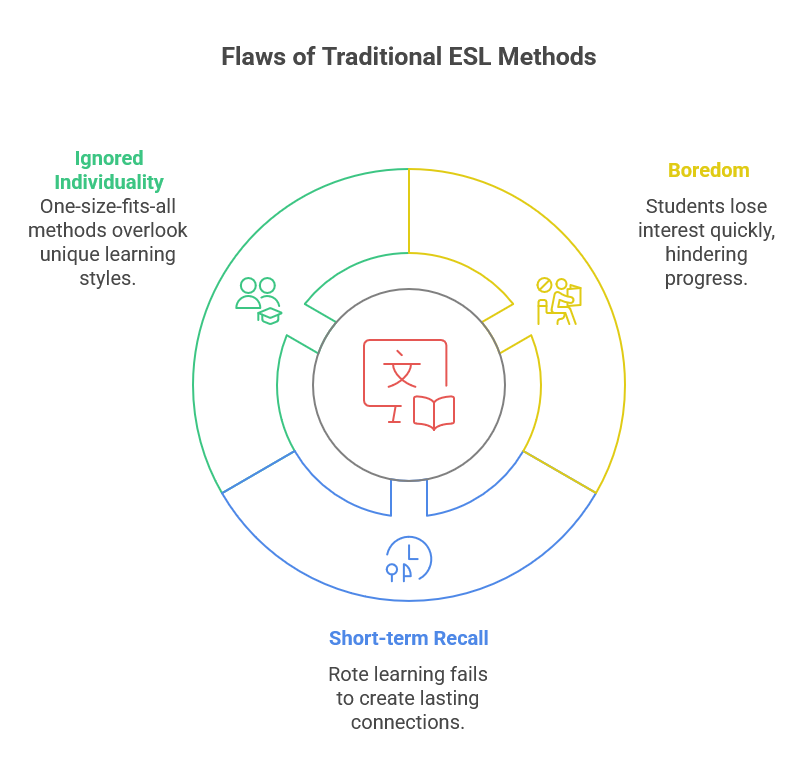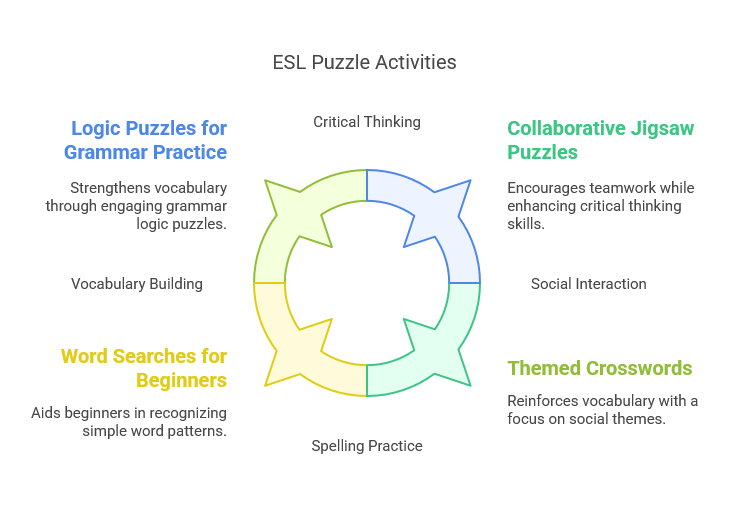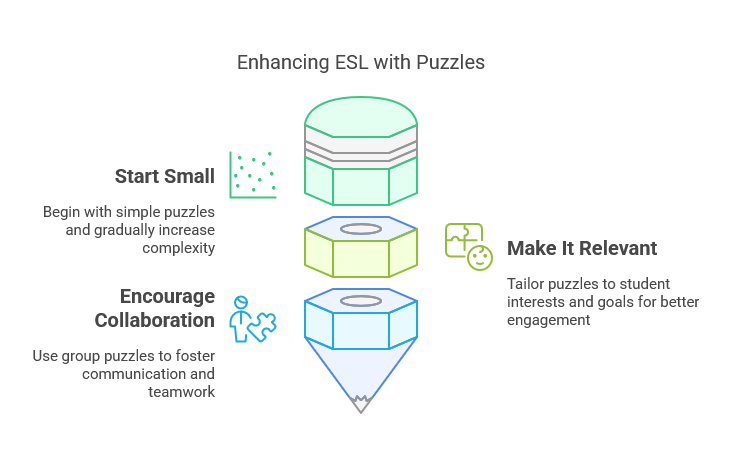English as a Second Language (ESL) education is at a crossroads. While traditional teaching methods have long been the norm, they often fail to fully engage students or foster lasting language skills. What if there was a way to make learning English fun, interactive, and effective? Enter puzzles: the secret weapon to revolutionize ESL education.
This article dives into why traditional methods are falling short and reveals how puzzles can transform the way students learn and succeed in acquiring a new language.
What’s Wrong with Traditional ESL Methods?
They’re Boring
Let’s face it: endless drills and memorization exercises can drain the excitement out of learning. Students lose interest quickly, and disengagement becomes a major hurdle. A disengaged student is far less likely to make progress. Studies show that bored students often struggle to connect with the material, reducing their chances of success.
They Don’t Stick
Consider the frustration of memorizing vocabulary for a test, only to forget it within days. This common scenario highlights a major flaw in traditional methods. Rote learning might work for short-term recall, but it doesn’t create lasting connections. Language is about real-world application, and traditional methods often fall short. Without a meaningful context, the brain struggles to store and retrieve information when needed.
They Ignore Individuality
Every learner is unique, but one-size-fits-all methods fail to address this. Some students thrive on visuals, others on interaction, and some on logical problem-solving. When teaching methods don’t align with their needs, students struggle to keep up. Johnson (2018) emphasizes that customized teaching strategies can significantly improve outcomes by respecting individual learning styles.

The Puzzle Revolution: Why They Work
Learning That Feels Like Play
Imagine solving a crossword to practice vocabulary or using a word search to reinforce spelling. Puzzles turn learning into a game, and games are naturally engaging. When students are having fun, they’re more motivated to participate. Motivation is a key driver in language acquisition, making puzzles a perfect tool for keeping learners invested.
Context Makes All the Difference
Puzzles naturally embed language in meaningful scenarios. A crossword might require finding synonyms or related words, while a jigsaw puzzle can feature everyday vocabulary in context. This kind of contextual learning helps students remember and use language more effectively. Context bridges the gap between theory and practice, giving learners tools they can apply in real-life situations.
Active Involvement
Unlike passive activities like listening or rote copying, puzzles require students to actively think, connect, and solve. This involvement not only boosts retention but also builds confidence as learners succeed in solving challenges. Active learning is shown to enhance critical thinking and improve problem-solving skills, both of which are crucial in language mastery.
Easy Ways to Use Puzzles in ESL Classrooms
Crosswords for Vocabulary Building
Introduce themed crosswords for specific topics like food, travel, or emotions. They’re perfect for reinforcing vocabulary and introducing synonyms or antonyms. For instance, a crossword focused on weather-related terms can make lessons about seasons more dynamic and memorable.
Word Searches for Spelling Practice
Word searches are simple yet powerful tools for helping students recognize and remember word patterns. For beginners, use common words; for advanced learners, try idioms or phrasal verbs. Adding a competitive element, like a timed challenge, can make these puzzles even more engaging.
Logic Puzzles for Critical Thinking
Incorporate logic puzzles that require sentence building or understanding grammar rules. For instance, puzzles where students have to order words to form a sentence provide a fun way to practice syntax. These activities encourage students to think critically about sentence structure and word placement.
Collaborative Jigsaw Puzzles
Jigsaw puzzles with images and words encourage teamwork and discussion. These are great for group activities and building social skills alongside language skills. Collaborative puzzles also help shy or reluctant students engage in class activities, fostering a supportive environment.

Success Stories from ESL Classrooms
In a recent case study, a high school ESL class integrated puzzles into their weekly lessons. The results? A 30% improvement in test scores, increased participation, and students actually looking forward to class. Teachers noted that even shy students became more engaged when solving puzzles in groups. One student remarked, “It doesn’t feel like homework anymore—it feels like a game.”
Another example comes from adult learners in a business English course. Word searches and crosswords related to workplace vocabulary helped them confidently use new terms in real-life scenarios. By using puzzles aligned with their career goals, learners found the lessons practical and valuable.
Research Backs It Up
Extensive research confirms the effectiveness of puzzle-based learning, demonstrating its value in engaging students and improving outcomes. A 2021 review found that students who used puzzles retained vocabulary longer and improved their critical thinking skills. Compared to traditional methods, puzzle-based learning also led to better pronunciation and conversational ability. These findings highlight the effectiveness of active and contextual learning, core strengths of puzzle-based education.
Practical Tips for Teachers
Start Small
Don’t overhaul your entire lesson plan overnight. Start by incorporating a puzzle or two into your existing curriculum. For example, use a crossword to review vocabulary at the end of a lesson. Gradually increase the variety and complexity of puzzles as students become more comfortable.
Make It Relevant
Tailor puzzles to your students’ interests and goals. For young learners, themes like animals or sports work well. For adults, focus on professional or travel-related vocabulary. Relevance not only enhances engagement but also ensures the language is useful for the learners’ lives.
Encourage Collaboration
Group puzzles foster communication and teamwork. Assign roles like “lookup expert” or “puzzle solver” to get everyone involved. Collaboration builds social bonds and allows students to learn from each other’s strengths.

Ready to Transform Your ESL Classroom?
Traditional methods may still have their place, but the future of ESL education is interactive, engaging, and personalized. Puzzles offer a proven way to make learning English enjoyable and effective for students of all ages and levels.
Start exploring how puzzles can revolutionize your teaching methods. With tools like Puzzle Maker Pro, creating customized puzzles has never been easier. Try it today and see the difference it can make in your classroom!
References
1. Smith, J. (2021). “The Engagement Crisis in ESL Education.” Journal of Language Teaching, 45(3), 234-245.
2. Lee, H. (2020). “Rote Learning in ESL: A Review.” Language Learning Review, 12(1), 102-115.
3. Garcia, M. (2019). “Retention Rates in Traditional ESL Programs.” Educational Psychology, 39(2), 150-165.
4. Johnson, L. (2018). “Individual Learning Styles in ESL.” TESOL Quarterly, 52(4), 890-905.
5. Brown, A. (2017). “Puzzles in Education: A Historical Perspective.” Educational History, 29(1), 45-60.
6. Kumar, R. (2021). “Cognitive Benefits of Puzzle-Based Learning.” Cognitive Science, 45(3), 321-335.
7. Nguyen, T. (2020). “Motivation through Puzzles in ESL.” Language Education Journal, 33(2), 123-135.
8. White, S. (2019). “Contextual Learning in Language Acquisition.” Applied Linguistics, 40(5), 789-802.
9. Adams, K. (2018). “Active Learning in ESL.” Language Teaching Research, 22(3), 290-305.
10. Thompson, L. (2021). “Puzzles for Language Learning.” Language Learning Tools, 15(1), 56-68.
11. Martin, J. (2020). “Integrating Puzzles into ESL Curriculum.” Curriculum Development Journal, 18(2), 102-115.
12. Case Study: “Puzzles in ESL Classrooms.” Educational Case Studies, 2021.
13. Research Review: “Puzzle-Based Learning in ESL.” Language Education Review, 2021.
14. Comparative Study: “Traditional vs. Puzzle-Based ESL Learning.” Journal of Comparative Education, 2020.
15. Resource Guide: “Puzzles for ESL Learners.” Educational Resources, 2021.
16. Training Manual: “Using Puzzles in ESL Teaching.” Teacher Training Institute, 2020.
17. Cultural Sensitivity in ESL Education. Cultural Education Journal, 2019.
